The global smart digital valve positioner market is valued at USD 359.7 million in 2025 and is slated to reach USD 542.8 million by 2035, recording an absolute increase of USD 183.1 million over the forecast period. This translates into a total growth of 50.9%, with the market forecast to expand at a compound annual growth rate (CAGR) of 4.2% between 2025 and 2035.
The overall market size is expected to grow by nearly 1.51X during the same period, supported by increasing demand for process automation technologies, growing adoption of Industry 4.0 solutions across manufacturing sectors, and rising preference for intelligent valve control systems across oil and gas, chemical processing, and power generation applications.
Between 2025 and 2030, the smart digital valve positioner market is projected to expand from USD 359.7 million to USD 441.9 million, resulting in a value increase of USD 82.2 million, which represents 44.9% of the total forecast growth for the decade.
This phase of development will be shaped by increasing adoption of digital transformation technologies, rising demand for predictive maintenance capabilities, and growing emphasis on process optimization systems with enhanced connectivity characteristics. Industrial automation providers are expanding their digital valve positioner capabilities to address the growing demand for smart manufacturing applications, remote monitoring, and integrated control system requirements.
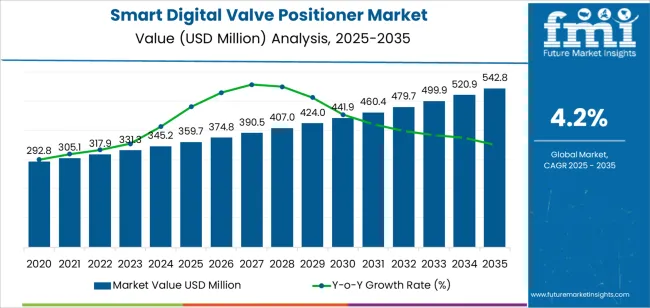
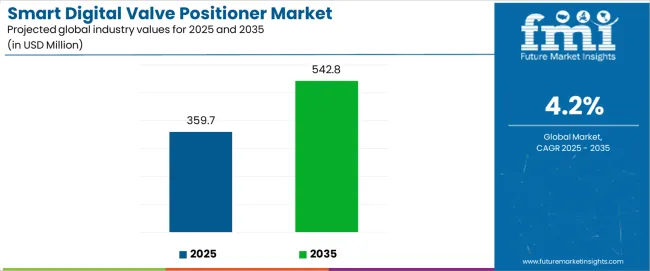
| Metric | Value |
|---|---|
| Estimated Value in (2025E) | USD 359.7 million |
| Forecast Value in (2035F) | USD 542.8 million |
| Forecast CAGR (2025 to 2035) | 4.2% |
From 2030 to 2035, the market is forecast to grow from USD 441.9 million to USD 542.8 million, adding another USD 100.9 million, which constitutes 55.1% of the overall ten-year expansion. This period is expected to be characterized by the expansion of IoT connectivity features, the integration of AI-powered diagnostics systems, and the development of wireless communication platforms with enhanced data analytics capabilities. The growing adoption of smart factory practices will drive demand for digital valve positioners with superior monitoring systems and compatibility with industrial management software across manufacturing operations.
Between 2020 and 2025, the smart digital valve positioner market experienced steady growth, driven by increasing demand for process automation technologies and growing recognition of digital valve control as essential components for efficient industrial operations across oil and gas processing, chemical manufacturing, and power generation applications.
The market developed as industrial operators recognized the potential for digital positioners to improve valve performance while maintaining operational reliability and enabling cost-effective maintenance protocols. Technological advancement in digital communication protocols and diagnostic capabilities began emphasizing the critical importance of maintaining control precision and operational visibility in complex industrial environments.
Market expansion is being supported by the increasing global demand for industrial automation solutions and the corresponding need for intelligent systems that can provide superior control precision and operational efficiency while enabling predictive maintenance and reduced operational costs across various process industries and manufacturing applications.
Modern industrial operations and process control specialists are increasingly focused on implementing digital valve technologies that can deliver enhanced control accuracy, prevent equipment failures, and provide consistent performance throughout complex processes and diverse operating conditions. Smart digital valve positioners' proven ability to deliver exceptional control precision against process variations, enable real-time diagnostics, and support cost-effective maintenance protocols make them essential components for contemporary industrial automation and process control operations.
The growing emphasis on operational efficiency and digital transformation is driving demand for smart digital valve positioners that can support large-scale industrial requirements, improve process control outcomes, and enable automated monitoring systems. Industrial operators' preference for technology that combines effective valve control with operational intelligence and maintenance efficiency is creating opportunities for innovative digital positioner implementations.
The rising influence of Industry 4.0 and smart manufacturing practices is also contributing to increased demand for digital valve positioners that can provide wireless communication, predictive analytics capabilities, and reliable performance across extended operational periods.
The smart digital valve positioner market is poised for steady growth and technological advancement. As industries across oil and gas, chemical processing, power generation, and manufacturing seek solutions that deliver exceptional control precision, operational intelligence, and maintenance efficiency, smart digital valve positioners are gaining prominence not just as control devices but as strategic enablers of modern process automation and industrial digitization.
Rising industrial automation adoption in Asia-Pacific and expanding digitalization initiatives globally amplify demand, while manufacturers are leveraging innovations in wireless communication systems, predictive diagnostics, and integrated monitoring technologies.
Pathways like wireless connectivity platforms, AI-powered diagnostics systems, and specialized application solutions promise strong margin uplift, especially in process-critical industrial segments. Geographic expansion and technology integration will capture volume, particularly where local industrial practices and automation adoption are critical. Regulatory support around industrial safety standards, emission control requirements, and operational efficiency mandates give structural support.
The market is segmented by type, application, communication protocol, end-use sector, and region. By type, the market is divided into linear positioners and rotary positioners categories. By application, it covers oil and gas, chemical, power generation, food and beverage, and others. By communication protocol, the market includes HART, Foundation Fieldbus, Profibus, and wireless systems. By end-use sector, it is categorized into process industries, manufacturing, utilities, and marine applications. Regionally, the market is divided into North America, Europe, East Asia, South Asia & Pacific, Latin America, and the Middle East & Africa.
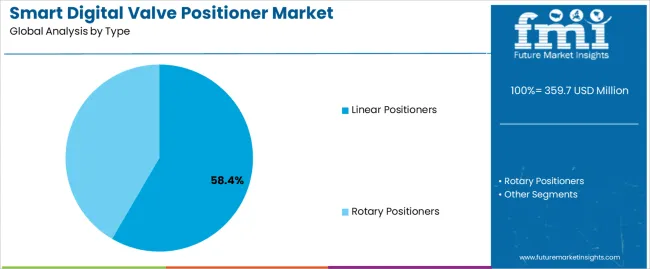
The linear positioners segment is projected to account for 58.4% of the smart digital valve positioner market in 2025, reaffirming its position as the leading technology category. Process industries and manufacturing operations increasingly utilize linear digital valve positioners for their superior control precision capabilities when operating with sliding stem valves, excellent flow control characteristics, and cost-effectiveness in applications ranging from process control to safety shutdown systems. Linear digital valve positioner technology's advanced feedback mechanisms and precise positioning capabilities directly address the industrial requirements for accurate flow control in process-critical environments.
This technology segment forms the foundation of modern process automation systems, as it represents the positioner type with the greatest compatibility and established market demand across multiple application categories and industrial sectors. Manufacturer investments in enhanced communication protocols and diagnostic capabilities continue to strengthen adoption among process industries and manufacturing enterprises. With companies prioritizing control accuracy and operational reliability, linear digital valve positioners align with both performance requirements and economic efficiency objectives, making them the central component of comprehensive process control strategies.
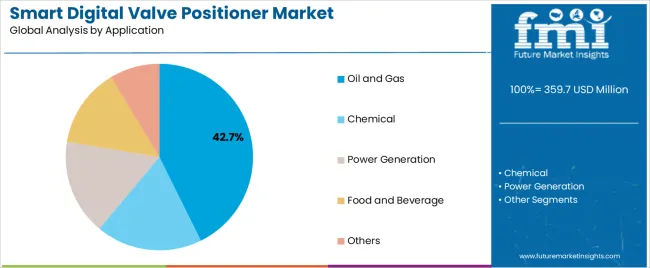
Oil and gas applications are projected to represent 42.7% of smart digital valve positioner demand in 2025, underscoring their critical role as the primary industrial consumers of precision valve control technology for upstream, midstream, and downstream operations. Oil and gas operators prefer smart digital valve positioners for their exceptional control reliability capabilities, harsh environment compatibility, and ability to maintain safety standards while ensuring effective process control throughout complex refining and production programs. Positioned as essential equipment for modern petrochemical operations, digital valve positioners offer both operational advantages and safety compliance benefits.
The segment is supported by continuous innovation in explosion-proof technologies and the growing availability of specialized communication systems that enable remote monitoring capabilities with enhanced safety features and rapid response characteristics. Additionally, oil and gas operators are investing in predictive maintenance systems to support large-scale valve automation and operational planning. As process safety demand becomes more prevalent and operational efficiency requirements increase, oil and gas applications will continue to dominate the end-use market while supporting advanced industrial automation utilization and process control strategies.
The smart digital valve positioner market is advancing steadily due to increasing demand for industrial automation technologies and growing adoption of digital process control solutions that provide superior positioning accuracy and operational intelligence while enabling predictive maintenance across diverse industrial and manufacturing applications. However, the market faces challenges, including high initial implementation costs, cybersecurity concerns, and the need for specialized technical expertise and integration complexity. Innovation in wireless communication capabilities and AI-powered diagnostic systems continues to influence product development and market expansion patterns.
Expansion of Wireless and IoT Technologies
The growing adoption of wireless communication protocols, IoT connectivity features, and cloud-based monitoring systems is enabling manufacturers to produce advanced digital valve positioners with superior data collection capabilities, enhanced remote access functionalities, and automated performance optimization features. Advanced wireless systems provide improved operational visibility while allowing more efficient maintenance planning and consistent monitoring across various industrial applications and operating environments. Manufacturers are increasingly recognizing the competitive advantages of IoT-enabled positioner capabilities for operational differentiation and premium market positioning.
Integration of Predictive Analytics and Digital Twin Technologies
Modern digital valve positioner producers are incorporating machine learning algorithms, predictive maintenance analytics, and digital twin modeling to enhance operational intelligence, enable proactive maintenance capabilities, and deliver value-added solutions to industrial customers. These technologies improve process efficiency while enabling new operational capabilities, including performance prediction, maintenance optimization, and reduced unplanned downtime. Advanced analytics integration also allows manufacturers to support comprehensive asset management systems and industrial optimization beyond traditional valve positioning approaches.
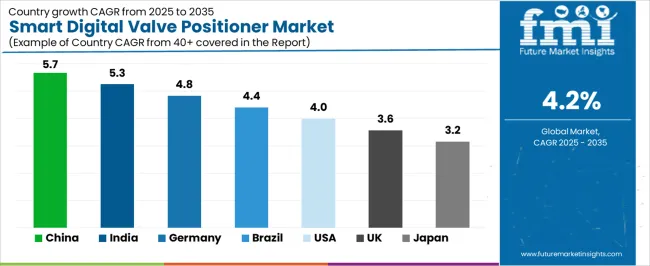
| Country | CAGR (2025 to 2035) |
|---|---|
| China | 5.67% |
| India | 5.25% |
| Germany | 4.83% |
| Brazil | 4.41% |
| USA | 3.99% |
| UK | 3.57% |
| Japan | 3.15% |
The smart digital valve positioner market is experiencing steady growth globally, with China leading at a 5.67% CAGR through 2035, driven by the expanding industrial automation programs, growing process industries development, and significant investment in manufacturing modernization. India follows at 5.25%, supported by government initiatives promoting industrial digitization, increasing manufacturing sector growth, and growing process control requirements. Germany shows growth at 4.83%, emphasizing industrial automation leadership and advanced manufacturing technology development.
Brazil records 4.41%, focusing on oil and gas sector expansion and industrial modernization. The USA demonstrates 3.99% growth, prioritizing industrial efficiency standards and process automation excellence. The UK exhibits 3.57% growth, emphasizing industrial technology adoption and manufacturing digitization. Japan shows 3.15% growth, supported by advanced manufacturing initiatives and precision control technology concentration.
The report covers an in-depth analysis of 40+ countries top-performing countries are highlighted below.
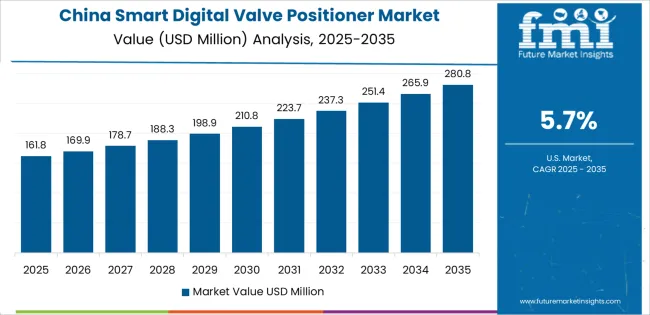
Revenue from smart digital valve positioners in China is projected to exhibit strong growth with a CAGR of 5.67% through 2035, driven by expanding industrial automation programs and rapidly growing process industries development supported by government initiatives promoting manufacturing modernization. The country's strong position in industrial manufacturing and increasing investment in smart factory infrastructure are creating substantial demand for advanced digital valve positioner solutions. Major industrial enterprises and manufacturing operations are establishing comprehensive automation capabilities to serve both domestic process control demand and industrial efficiency markets.
Revenue from smart digital valve positioners in India is expanding at a CAGR of 5.25%, supported by the country's growing manufacturing sector, expanding government support for industrial digitization, and increasing adoption of process automation solutions. The country's initiatives promoting industrial technology and growing industrial awareness are driving requirements for advanced process control capabilities. International suppliers and domestic manufacturers are establishing extensive production and service capabilities to address the growing demand for digital valve positioner products.
Revenue from smart digital valve positioners in Germany is expanding at a CAGR of 4.83%, supported by the country's advanced industrial automation capabilities, strong emphasis on manufacturing technology innovation, and robust demand for high-performance process control systems in chemical processing and manufacturing applications. The nation's mature industrial sector and efficiency-focused operations are driving sophisticated digital valve positioner systems throughout the manufacturing industry. Leading manufacturers and technology providers are investing extensively in Industry 4.0 solutions and precision control technologies to serve both domestic and international markets.
Revenue from smart digital valve positioners in Brazil is growing at a CAGR of 4.41%, driven by the country's expanding oil and gas sector, growing industrial operations, and increasing investment in process automation development. Brazil's large petrochemical industry and commitment to industrial modernization are supporting demand for reliable digital valve positioner solutions across multiple process control segments. Manufacturers are establishing comprehensive service capabilities to serve the growing domestic market and industrial export opportunities.
Revenue from smart digital valve positioners in the USA is expanding at a CAGR of 3.99%, supported by the country's advanced process control technology sector, strategic focus on industrial efficiency, and established automation capabilities. The USA's industrial innovation leadership and technology integration are driving demand for digital valve positioners in chemical processing, oil and gas, and manufacturing applications. Manufacturers are investing in comprehensive technology development to serve both domestic industrial markets and international specialized applications.
Revenue from smart digital valve positioners in the UK is growing at a CAGR of 3.57%, driven by the country's focus on industrial technology advancement, emphasis on manufacturing efficiency, and strong position in process control development. The UK's established industrial innovation capabilities and commitment to manufacturing modernization are supporting investment in advanced valve positioning technologies throughout major industrial regions. Industry leaders are establishing comprehensive technology integration systems to serve domestic manufacturing operations and specialized industrial applications.
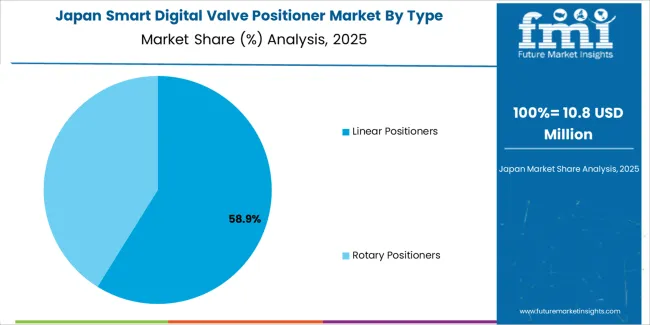
Revenue from smart digital valve positioners in Japan is expanding at a CAGR of 3.15%, supported by the country's advanced manufacturing initiatives, growing precision control sector, and strategic emphasis on industrial automation development. Japan's proven technology capabilities and integrated manufacturing systems are driving demand for advanced digital valve positioners in precision manufacturing, process control, and high-performance industrial applications. Leading manufacturers are investing in specialized capabilities to serve the stringent requirements of advanced manufacturing and precision control industries.
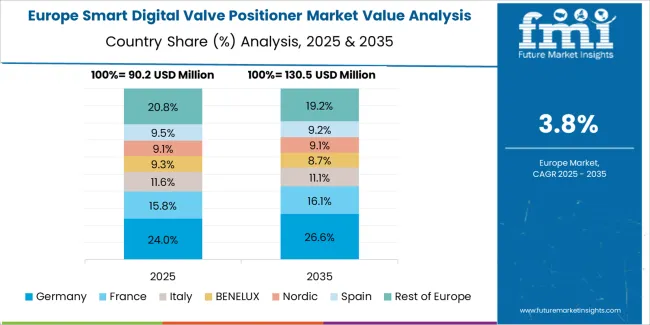
The smart digital valve positioner market in Europe is projected to grow from USD 72.1 million in 2025 to USD 108.6 million by 2035, registering a CAGR of 4.2% over the forecast period. Germany is expected to maintain its leadership position with a 38.5% market share in 2025, declining slightly to 37.8% by 2035, supported by its strong industrial automation sector, advanced manufacturing technology capabilities, and comprehensive process control industry serving diverse valve positioner applications across Europe.
France follows with a 16.2% share in 2025, projected to reach 16.8% by 2035, driven by robust demand for digital valve positioners in chemical processing, industrial modernization programs, and process automation applications, combined with established industrial technology infrastructure and manufacturing expertise.
The United Kingdom holds a 15.4% share in 2025, expected to reach 15.9% by 2035, supported by strong industrial technology sector and growing process automation activities. Italy commands a 11.8% share in 2025, projected to reach 12.2% by 2035, while Spain accounts for 8.7% in 2025, expected to reach 9.1% by 2035.
The Netherlands maintains a 5.9% share in 2025, growing to 6.1% by 2035. The Rest of Europe region, including Nordic countries, Eastern Europe, Belgium, Poland, and other nations, is anticipated to maintain momentum, with its collective share moving from 3.5% to 2.1% by 2035, attributed to increasing industrial modernization in Eastern Europe and growing process automation penetration in Nordic countries implementing advanced manufacturing technology programs.
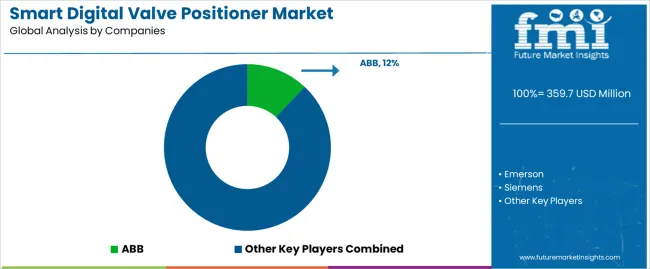
The smart digital valve positioner market is characterized by competition among established industrial automation companies, specialized valve control technology producers, and integrated process control solutions providers. Companies are investing in wireless communication technology research, diagnostic capability optimization, predictive maintenance system development, and comprehensive product portfolios to deliver consistent, high-performance, and application-specific digital valve positioner solutions. Innovation in IoT connectivity, AI-powered diagnostics, and operational efficiency enhancement is central to strengthening market position and competitive advantage.
ABB leads the market with a strong market share, offering comprehensive digital valve positioner solutions including advanced diagnostic capabilities with a focus on process industries and industrial automation applications. Emerson provides specialized process control capabilities with an emphasis on predictive maintenance systems and integrated plant operations. Siemens delivers innovative industrial automation products with a focus on digital communication platforms and manufacturing integration services.
Baker Hughes specializes in oil and gas automation and valve positioning technologies for energy sector applications. Schneider Electric focuses on industrial automation equipment and integrated process solutions. SMC offers specialized pneumatic and process control technologies with emphasis on manufacturing and industrial applications.
| Items | Values |
|---|---|
| Quantitative Units (2025) | USD 359.7 million |
| Type | Linear Positioners, Rotary Positioners |
| Application | Oil and Gas, Chemical, Power Generation, Food and Beverage, Others |
| Communication Protocol | HART, Foundation Fieldbus, Profibus , Wireless Systems |
| End-Use Sector | Process Industries, Manufacturing, Utilities, Marine Applications |
| Regions Covered | North America, Europe, East Asia, South Asia & Pacific, Latin America, Middle East & Africa |
| Countries Covered | China, India, Germany, Brazil, United States, United Kingdom, Japan and 40+ countries |
| Key Companies Profiled | ABB, Emerson, Siemens, Baker Hughes, Schneider Electric, and SMC |
| Additional Attributes | Dollar sales by type and application category, regional demand trends, competitive landscape, technological advancements in wireless communication systems, predictive diagnostics development, IoT integration innovation, and industrial automation integration |
The global smart digital valve positioner market is estimated to be valued at USD 359.7 million in 2025.
The market size for the smart digital valve positioner market is projected to reach USD 542.8 million by 2035.
The smart digital valve positioner market is expected to grow at a 4.2% CAGR between 2025 and 2035.
The key product types in smart digital valve positioner market are linear positioners and rotary positioners.
In terms of application, oil and gas segment to command 42.7% share in the smart digital valve positioner market in 2025.






Full Research Suite comprises of:
Market outlook & trends analysis
Interviews & case studies
Strategic recommendations
Vendor profiles & capabilities analysis
5-year forecasts
8 regions and 60+ country-level data splits
Market segment data splits
12 months of continuous data updates
DELIVERED AS:
PDF EXCEL ONLINE
Smart Card IC Market Size and Share Forecast Outlook 2025 to 2035
Smart-Tag Inlay Inserters Market Analysis - Size and Share Forecast Outlook 2025 to 2035
Smart Wheelchair Market Forecast and Outlook 2025 to 2035
Smart TV Market Forecast and Outlook 2025 to 2035
Smart/AI Toy Market Size and Share Forecast Outlook 2025 to 2035
Smart Locks Market Size and Share Forecast Outlook 2025 to 2035
Smart Sprinkler Controller Market Size and Share Forecast Outlook 2025 to 2035
Smart Indoor Gardening System Market Size and Share Forecast Outlook 2025 to 2035
Smart Building Delivery Robot Market Size and Share Forecast Outlook 2025 to 2035
Smart Watch Market Size and Share Forecast Outlook 2025 to 2035
Smart Label Market Size and Share Forecast Outlook 2025 to 2035
Smart Mat Market Size and Share Forecast Outlook 2025 to 2035
Smart Water Management Market Size and Share Forecast Outlook 2025 to 2035
Smart Built-In Kitchen Appliance Market Size and Share Forecast Outlook 2025 to 2035
Smart Cold Therapy Machine Market Size and Share Forecast Outlook 2025 to 2035
Smart Personal Assistance Devices Market Size and Share Forecast Outlook 2025 to 2035
Smart Speaker Market Size and Share Forecast Outlook 2025 to 2035
Smart Vehicle Architecture Market Size and Share Forecast Outlook 2025 to 2035
Smart City Platforms Market Size and Share Forecast Outlook 2025 to 2035
Smart Doorbell Market Size and Share Forecast Outlook 2025 to 2035

Thank you!
You will receive an email from our Business Development Manager. Please be sure to check your SPAM/JUNK folder too.
Chat With
MaRIA